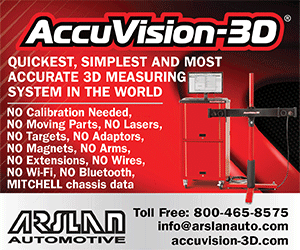
Toronto, Ontario — Last week, Reuters released a story that provided a flawed look at the conflict over ADAS between OEMs and aftermarket part makers.
While the piece was most reflective of the American auto sector, it was picked up around the world.
If the results of Collision Repair’s post-election survey are any guide, it is a safe bet that most of our readers saw it in the National Post, where it ran on the uninspired headline: Carmakers and repair shops clash as automation upends aftermarket.
Fair warning, though the piece is a worthwhile read, it is not reflective of the actual on-the-ground struggle between auto manufacturers and aftermarket parts makers.
For one thing, the piece suggests that independent facilities and facilities uncertified by an OEM certification program are the same thing.
For another, the author appears to be unaware of the existence of remote diagnostic repair procedures, suggesting that only by a shop buying an OEM tool could ADAS systems be reliably scanned by the facility.
Broadly, the piece suggests that, without ADAS equipment from aftermarket parts providers, these independents—said to be cut-off from OEM parts—will be driven out of business.
While, in the U.S., there have been a few OEMs that have tried to limit parts availability to non-certified repairers, this is not the norm. It is not the case in Canada at all.
I should also mention that it depicts non-certified repair facilities as being fellow-travellers of fortune with aftermarket parts producers.
Why am I bringing this up? Because before I read the piece, I’d written one on a similar topic—and felt it was interesting to highlight what the broader public’s understanding of the issue was being shaped.
———————————————–
We live in the semi-autonomous epoch, even though we don’t realize it.
By the end of the century, auto historians will look at today’s vehicles, with their advanced driver assistance systems sensors, as an intermediary form between traditional and entirely autonomous automobiles.
While human drivers have remained in control, vehicle hardware has—over the past few years—become an increasingly competent co-pilot. In the next few years, the hardware is likely to start filling the role of the driver, relegating humans to a co-piloting position.
Not too much later—perhaps within a couple of model years—we humans will all become but humble passengers.
The problem is that we don’t see ourselves as living—and repairing—in a particularly interesting period-of-transition.
The relationship between repairers working today and ADAS hardware is largely peripheral and often a source of mild annoyance for repairers.
If you can’t pull a dent without compromising a nearby sensor, you can’t pull the dent at all. If using your welder of choice will mess with the sensitive electronics of the ADAS hardware, use a different welder.
While most businesses are not making a total hash of repairing ADAS systems, not everyone is judiciously scanning and calibrating as often as they should. According to the results of one J.D. Power study, more than one-in-eight ADAS-equipped vehicles have safety systems fail after any given repair procedure.
Sure—this sounds worse to industry outsiders than to anyone who makes their living repairing vehicles. A misaligned lane-assist system may cause a vehicle to drift in a dangerous way, but the driver can still issue corrective orders. And while a lot is being said about dangerous-sounding emergency braking system failures on highways, these problems don’t seem to be connected to repairer error.
Overblown as the concerns about repairs causing ADAS issues may be, it is time for the collision community to stop viewing ADAS as a complicating factor, and, instead, as an integral component of a vehicles’ design—as integral as any quarter panel.
In this year’s models, the systems can be found in most new base models—not just as an option. In a few year’s time, they will be taking the reins.
By that point, any business that isn’t treating ADAS as integral will be finished—as will the owners, should the ADAS systems have mastered the art of revenge.
It may, however, be worse for the owners. Given the rate of technological progression, perhaps the vehicles will begin to strike back—and sooner than we think.





















